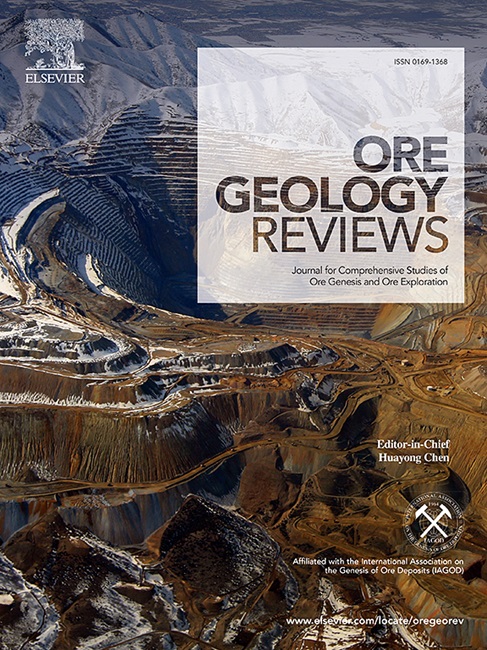Critical metals Ga and Ge enrichment in the last-stage and low-temperature sphalerite from the Guojiagou Zn-Pb deposit, western Qinling Orogen, NW China
IF 3.2
2区 地球科学
Q1 GEOLOGY
引用次数: 0
Abstract
Gallium (Ga) and germanium (Ge) have been designated as globally critical metals, driven by their elevating demand and supply risks in high-tech industries such as solar energy, optoelectronics, and green energy. The Xicheng-Fengtai Orefield, situated within the Qinling Orogen of Northwest China, contains over 20 million tons of Zn-Pb metals and thereby is a world-class Zn-Pb orefield hosted in sedimentary rocks. Nevertheless, the potential for Ga and Ge resources in this region has yet to be comprehensively assessed. To investigate this matter further, we selected the representative Guojiagou Zn-Pb deposit to conduct an extensive series of field investigations complemented by micropetrograhic observations and advanced analytical techniques including electron probe microanalysis (EPMA) and laser ablation inductively coupled plasma mass spectrometry (LA-ICP-MS). At the Guojiagou, sulfide mineralization precipitated from brine fluids transporting metals from the basement, resulting in over 3 Mt of Zn-Pb (with 3.34 % Zn and 1.26 % Pb), and was accompanied by extensive ankeritization, silicification, and calcitization. The multifaceted approach enabled us to elucidate mineral paragenesis, sphalerite generations, and their chemical compositions. Our analysis revealed three distinct types of sphalerite: 1) the earliest dark-brown Sp1 intergrown with ankerite; 2) the subsequent brownish-red Sp2 associated with massive pyrite; and 3) the later light-colored Sp3 linked with calcite veins. EPMA and LA-ICP-MS analyses demonstrated that the last crystallized Sp3 exhibits significantly elevated concentrations of Ga (mean = 139.2 ppm) and Ge (mean = 160.9 ppm), surpassing those found in earlier stages: Sp1 (Ga mean = 20.0 ppm; Ge mean = 1.4 ppm) and Sp2 (Ga mean = 31.2 ppm; Ge mean = 4.6 ppm). Binary correlation diagrams for specific elements indicate that Ga integrates into sphalerite’s crystal lattice via Ga3+ + Cu+ ↔ 2Zn2+ while Ge incorporates into its structure through mechanisms such as Ge4+ + 2Ag+ ↔ 3Zn2+ or Ge2+ ↔ Cd2+ pathways. Furthermore, GGIMFis sphalerite geothermometer results suggest a decreasing trend in ore-forming temperatures from approximately 180–230 °C for earlier forms like Sp1 and Sp2 down to about 120–150 °C for late-stage Sp3. Concurrently, sulfur fugacity values logfS2 exhibit a gradual decline from -15 to -10 for both early stages towards -22 to -14 for late-stage Sp3. The widespread occurrence of ankerite combined with low manganese concentrations, mainly ranging from 0 to 20 ppm, supports our assertion that the Guojiagou’s ore fluids were relatively oxidizing—these oxidizing fluids mixing with reduced sulfur generated through thermal reduction of sulfate minerals (TSR), ultimately leading to substantial precipitation of Zn-Pb ores across the site. Our novel findings regarding Ga and Ge concentrations—coupled with reserve estimates—suggest approximate reserves amounting to around 240 tons of Ga alongside approximately 219 tons of Ge within the Guojiagou Zn-Pb deposit. These discoveries underscore significant potential and highlight strategic exploration avenues concerning both Ga and Ge resources present at the Guojiagou and analogous sites throughout western Qinling Orogen in Northwest China.

求助全文
约1分钟内获得全文
求助全文
来源期刊

Ore Geology Reviews
地学-地质学
CiteScore
6.50
自引率
27.30%
发文量
546
审稿时长
22.9 weeks
期刊介绍:
Ore Geology Reviews aims to familiarize all earth scientists with recent advances in a number of interconnected disciplines related to the study of, and search for, ore deposits. The reviews range from brief to longer contributions, but the journal preferentially publishes manuscripts that fill the niche between the commonly shorter journal articles and the comprehensive book coverages, and thus has a special appeal to many authors and readers.
 求助内容:
求助内容: 应助结果提醒方式:
应助结果提醒方式:


